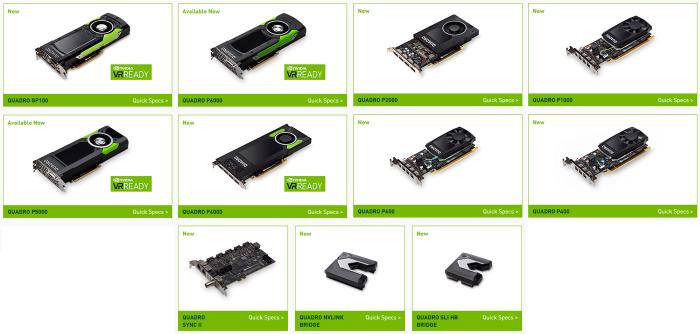Over the weekend Nvidia has introduced several new products to its Quadro range of professional graphics cards. The new Quadro GP100, P4000, P2000, P1000, P600 and P400 are all based on Pascal architecture GPUs. Nvidia targets these cards for adoption in desktop workstations used for complex design tasks, photorealism, virtual reality, artificial intelligence, and deep learning.

The top end solution introduced this weekend, the Quadro GP100, gets the most attention as it has all the headline grabbing big numbers. Bob Pette, vice president of Professional Visualization at Nvidia, even says that the Quadro GP100 "transforms the average desktop workstation with the power of a supercomputer". A number of bullet points, mostly to do with the GP100's features and performance, help to back up Pette's statement:
- Unify simulation, HPC, rendering and design - The GP100 combines unprecedented double precision performance with 16GB of high-bandwidth memory (HBM2) so users can conduct simulations during the design process and gather realistic multiphysics simulations faster than ever before. Customers can combine two GP100 GPUs with NVLink technology and scale to 32GB of HBM2 to create a massive visual computing solution on a single workstation.
- Explore deep learning - The GP100 provides more than 20 TFLOPS of 16-bit floating point precision computing - making it an ideal development platform to enable deep learning in Windows and Linux environments.
- Incorporate VR into design and simulation workflows - The 'VR Ready' Quadro GP100 and P4000 have the power to create detailed, lifelike, immersive environments. Larger, more complex designs can be experienced at scale.
- Reap the benefits of photorealistic design - Pascal-based Quadro GPUs can render photorealistic images more than 18 times faster than a CPU.
- Create expansive visual workspaces - Visualize data in high resolution and HDR colour on up to four 5K displays.

QUADRO GP100 QUICK SPECS:
- CUDA Parallel-Processing Cores: 3,584
- GPU Memory: 16GB HBM2
- FP64 Performance: 5.2 TFLOPS
- FP32 Performance: 10.3 TFLOPS
- FP16 Performance: 20.7 TFLOPS
- Max Power Consumption: 235W
- Graphics Bus: PCI Express 3.0 x 16
- Display Connectors: DP 1.4 (4), DVI-D (1), Optional Stereo (1)
- Form Factor: 4.4” H x 10.5” L Dual Slot
It's worth pointing out that the Quadro GP100 is the first product to bring NVLink to Windows systems. The technology is faster than SLI and utilises the new Quadro NVLink bridge [for up to 80GB/s bi-directional (with two bridges)]. As mentioned above, these cards are not meant for gaming but they can be put into 'GeForce mode' for gaming if you wish, says Nvidia.
You can look through the entire range of Quadro Pascal graphics cards, including the previously announced P6000 and P5000, on the Nvidia Quadro with Pascal home page, with pop-up quick spec information. With the introduction of the Quadro GP100, P4000, P2000, P1000, P600 and P400 Nvidia has a total of eight visual computing solutions to meet professional needs. Thanks to Nvidia's update, the whole Quadro range now supports the latest CUDA 8 compute platform.














